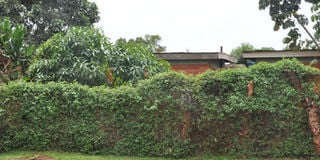When you choose a natural fence

A residential house with a growing natural fence in Bbunga, a Kampala suburb. Photo by Shabibah Nakirigya
What you need to know:
If you do not live in a densely populated place, a natural fence is a good choice as it does not only let in fresh air but also lets you to see the outside world with ease
Do you hate to be enclosed and yet want a bit of privacy once in a while? Then, planting a natural fences is the answer for you. With it, you can enjoy beauty and keep your home in perfect condition without worrying about unsettling the natural order outside your home. While at it, choose the right flowers, plants and shrubs to plant.
Erias Nkoyoyo, a compound innovator from Stone Roofings Limited saysbeautiful flowering plants will suit a homeowner in a leeward side who has no reason to be concerned with the threat of wind erosion.
Not only do these plants make good natural fences but are also beautiful to look at. Their vegetation is scattered with delicate, colourful flowers, which will add visual attraction to any garden or compound. Flowering shrubs attract insects that in turn help pollinate them and prolong their lives.
Choosing basic variety
of plant or climber
Nkoyoyo says that people commonly use plants such as privet, laurel, yew or holly because they make beautiful natural fences. These flowers tend to grow tall and develop thick vegetation which promotes privacy and evicts pests.
Shrubs can be prepared into equal designs or planted in combination with other flowering plants, adding visual appeal to your property.
To keep away intruders, select rough plant species. These plants are usually quite strong that they can survive long periods with little or no water for years.
But be careful when selecting rich species to use as a living fence, as they can easily spread out of control if they are not carefully maintained.
Cactus and similar plants are good for dry, arid climates where other types of plants have difficulty thriving.
Decide where the fence will go
Nkoyoyo advises that you review your home to determine where you want to plant your line of shrubs. If you own livestock or a big piece of land, you might choose to straighten the fence around the outside boundary of your home.
If you are planting a fence for beautiful reasons or to give you more privacy, put some thought into your desired layout for the area you are working with .




